|
|
Ferrari 458 Italia
|
 |
|
|
Debut: 2009
Maker: Ferrari
Predecessor:
F430
|
|
|
|
Published
on 5
Dec 2009
|
All rights reserved.
|
|
|
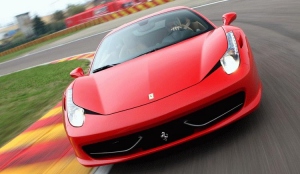
|
It laps Fiorano in 1 min 25 sec, the
same time as Enzo. Is this really a production Ferrari V8 model ?
|
It
goes from rest to 60 mph
in 3.2 seconds. It tops 202 mph on long straight. It laps Ferrari's
Fiorano test track in 1 min 25 sec, the same time as Enzo did a few
years back. Is this really a production Ferrari V8 model ?
Once upon a time, Ferrari 308GTB was born as an equivalent of Porsche's
entry-level 911 Carrera. It was cheap to buy and run. It was less
temperamental than the V12 models. It was user-friendly enough to be
the daily transport of Magnum PI. Things didn't change much with 328
and 348. But when Ferrari destined to put its Testarossa series into
retirement, F355 was given plenty of space to migrate up market. It got
a 25 percent jump in horsepower and a similar jump in price. Next one,
the aluminum chassis 360 Modena, continued the rise in performance and
social ranking. By the time F430 arrived, it already boosted nearly 500
horsepower, capable of 196 mph and a 0-60 mph time of 3.6 seconds.
Breaking the 200 mph barrier is just a matter of time.
Especially now the 458 Italia is no longer the entry-level model of
Maranello – that role is taken up by California. Ferrari can
therefore lift its price by 10 percent to some £160,000. In
return, you get a standard dual-clutch gearbox and ceramic brakes, as
much as 80 extra horsepower and a true 9000 rpm redline. It's time to
recalibrate our perception of the V8 model. Fewer cylinders it might
have compared with V12 models, but it is no less exotic. In fact, I
suspect its lighter weight and compacter packaging might result in a
better supercar than the mighty 599GTB...
Styling
and Aerodynamics
When I first saw the photos of 458
Italia, the first impression came in mind was: this is a modern-day
Dino, isn't it ? Look at that sexy waistline, it is the trademark of
Dino. Flowing dramatically over both wheel arches and dropping deep in
the middle section to enable large side window, it helps delivering a
slimmer, lighter and more dynamic appearance than 360 Modena and F430.
Other design elements also contribute
to this sleekness. The nose is
set lower than that of the F430, leading to a faster front bonnet. The
frontal surface of the nose is no longer a bulky bumper like its
predecessor's, but a large, blackened pseudo intake, which leads to a
slimmer front end look. The longitudinal headlights, each incorporates
a xenon lamp and 20 LED elements, also contribute to the slimness, as
do the rising flanks either side of the bonnet. Follow closely the
bonnet is a fast windscreen set ever closer to the front axle. In
other words, this is a "cab-forward" proportion.
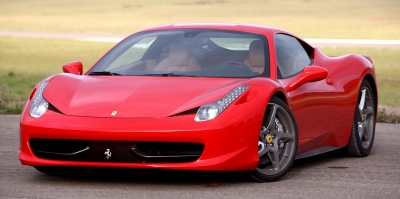
|
First impression: this is a modern-day
Dino !
|
Great designs can deceive your eyes. Behind that slimmer and
lighter
appearance is a slightly larger car - the 458 is actually 15mm longer,
14mm wider and just 1mm lower than F430. Its wheelbase has grown from
2600mm to 2650mm. All four wheels are pushed further towards the
corners, both longitudinally and transversely, to enhance stability.
Visually, it also delivers a sense of immense stability. The larger,
20-inch wheels with low-profile rubbers fill the wheel arches so fully.
The Enzo-derived rear design emphasizes downforce. What about the
centrally-located triple exhaust ? Aren't they familiar ? Yes, they
take shape from the legendary F40. Not just for looks, they are
configured so with reason - the central pipe works at low rpm, while
the outer two work at higher rpm to reduce back pressure.
Forms without functions would not be
the work of Ferrari.
Pininfarina's imagination is always under close guard of the
aerodynamists at Maranello. In the development of 458 Italia, the
latest fluid dynamic computation technology from F1 was employed to
analyse
drag and lift before putting the final prototype into wind tunnel. In
terms of aerodynamics, Ferrari is definitely the best in the industry.
While Porsche prefers low drag to make the most speed from its limited
engine output, horsepower has never been in short supply to Ferrari.
Therefore it can spend more effort on generating downforce, hence
improving real world performance.
The 458 has a drag coefficient of
0.33, slightly better than its
predecessor. However, it generates 360 kilograms of positive downforce
at top speed, compare to 280 kg in the case of F430. Such downforce is
distributed 41:59 between front and rear axle, nearly identical to the
static weight distribution of 42:58. This mean its chassis balance is
hardly influenced by speed.
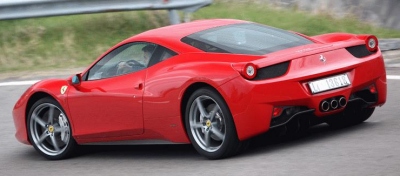
|
It generates 360 kg of positive
downforce at top speed, compare to 280 kg of F430...
|
Many design elements contribute to
this superb aerodynamics.
For example:
- The small intakes inboard of the
headlamps are not styling
gimmicks. They draw air transversely towards the outlets outboard of
the lamps, lowering the speed of airflow over the front fenders, thus
reducing aerodynamic lift.
- The two intakes at the nose, which
serve the radiators for
engine coolant, are accompanied with winglets made of aeroelastic
material. At speed the latter deform to reduce the frontal area of
radiator intakes and cut drag.
- The oil radiators for gearbox are
situated in the tail, with
air fed from the two intakes on the top of the rear fenders. The hot
air from these radiators creates a base bleed effect, venting directly
into the car's low-pressure zone behind the tail and reducing drag.
- Engine bay cooling is implemented by
the intakes located on
the smooth underbody just ahead of rear wheels, where part-vacuum
builds naturally to help sucking the air efficiently. The airflow goes
up and exits at the outlets beside the taillights, helps generating
downforce.
- The engine breathes from the intakes
located behind the side
quarter windows. At high speed, ram air effect contributes to 5 of the
570 horsepower.
Chassis and Suspensions
The
chassis of 458 is once again made of aluminum spaceframe, which is
glued and welded from aluminum castings, extrusions and stamped parts.
American aluminum giant Alcoa has a small plant at Maranello supplying
spaceframes to Ferrari. This year it brings a new kind of aluminum
alloy and a new manufacturing process - heat forming - to improve
stiffness to weight ratio. For example, thickness of the roof panel,
front bonnet and door skins are reduced to just 1mm without hurting
stiffness. Overall, the 458 chassis has a torsional rigidity 15 percent
higher than that of F430 without adding weight.
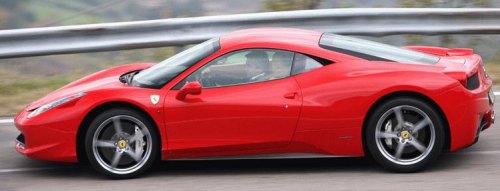
Torsional rigidty is up by 15%
|
|
The whole vehicle, however, weighs 35 kilograms more than
F430, mostly due to the new double-clutch gearbox (which accounts for
25 kg alone) and other performance enhancement. Nevertheless, with a
significantly more powerful engine, power to weight ratio is still
dramatically improved. After all, with a kerb weight of 1485 kg, 458
Italia is still a lightweight machine. For comparison, the latest
Porsche 911 Turbo is 110 kilograms heavier. Only Lamborghini Gallardo
Balboni is lighter, but then it undercuts the Ferrari by no more than
the weight of a brief case.
Changes to the suspensions are more radical. The front double-wishbone
units get a new, L-shape lower wishbone which increases longitudinal
flexibility for better ride comfort and lifts transverse rigidity for
better roadholding. The rear suspensions have abandoned traditional
double-wishbones for a new multi-link setup, like California. Its
higher vertical rigidity results in less body roll, and more precise
geometry allows engineers to adopt a more direct, 2.0 turns lock to
lock steering. The latter has great influence to its handling, as we
shall see soon. Another important upgrade is the adoption of Delphi magnetorheological adaptive
dampers. It allows the Italia to adjust damping stiffness infinitely by
varying electrical current to the magnetic fluid inside the dampers.
Moreover, this is the second generation system. Compare with the first
generation used in 599GTB and California, its response time is halved,
internal friction is reduced, thus deal better with high-frequency
small bumps on the road.
Amazing Engine
Much improved the chassis and suspension may be, I would say the most
sensational element of 458 Italia is still its 4.5-liter V8 engine,
which gives the name of this car.
There was a time when 100 horsepower per liter was deemed to be the
upper limit of naturally aspirated engines. Ferrari broke that barrier
in 1994 with F355, whose 5 valve per cylinder V8 produced 109
horsepower per liter. In the following years, the figure rose steadily
to 112 in Modena, 114 in F430 and eventually 118 in Scuderia.
Astonishingly, even at this high level the latest Ferrari V8 is still
able to take a giant leap. The 4.5-liter motor pumps out 570 horsepower
at a record 9000 rpm, translating to a specific output of 127 hp/liter
!! This is once again the most efficient naturally aspirated engine in
the world, one that easily beat a Porsche 911 GT3 (115 hp/liter) and
even eclipses the mighty little four-cylinder VTEC motor of Honda S2000
(120 hp/liter). How can it achieve that ?
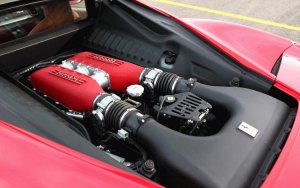
|
New direct-injected V8 sets new record
in revability and specific output... as well as specific torque...
|
From
outside, the red-head
motor looks like just another evolution of the F136 V8 family which
powered F430 and California. It shares the same bore center spacing and
the same basic block with the 4.3-liter unit of California. Ditto the
trademark flat plane crankshaft for light rotational mass and
quad-continous variable valve timing. However, most of its internals
are heavily modified to enable and take on extra grunt. The engine is
stroked to 4497 cc, taking its combustion chambers to less oversquared
dimensions (94mm bore x 81mm stroke). Direct fuel injection improves
its fuel efficiency as well as enables a 12.5:1 compression ratio. The
latter is even higher than that of California (12.2:1), thanks to the
adoption of ion-current knock sensing technology from 430 Scuderia.
As always, the Ferrari V8 employs forged aluminum pistons and
lightweight titanium connecting rods to enhance revability, but that
alone is not enough to raise its redline to 9000 rpm. Undoubtedly, more
friction has to be removed from the reciprocating parts. To do so,
the F136FB engine employs shorter pistons with thinner piston rings and
graphite coated piston skirts. The cam lobes have microfinishing and
the valve tappets have diamond-like carbon coating. Even the
lubrication system have been overhauled to reduce friction and windage.
Unlike other engines, its crankcase is sealed in two separate chambers,
one for the two inner pairs of cylinders and one for the two outer
pairs of cylinders. Each chamber has its own oil pump. As the
flat-crank V8 has the two inner pairs of crank throws situated at
the same angle (the same goes for the two outer pairs, which are
180-degree out of phase to the inner pairs), this arrangement prevents
air goes repeatedly from one crank throw to another crank throw,
reducing windage or pumping loss within the crankcase. Besides, the
on-demand variable geometry oil pumps saves fuel as well as up to 6
horsepower at high rpm.
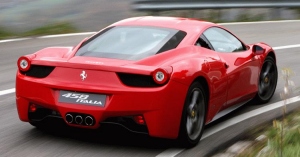
|
Fuel consumption and emission is cut
by a quarter !
|
In this way, the new Ferrari V8 has a rev range wider than
any other road-going piston engines in the world today (remark: the
late Honda S2000 and the rotary-engined Mazda RX-8 share the same
record with it though). This explain why it needs a 4-stage resonance
variable intake system to serve the whole rev range. The two intake
plenums are interconnected by 3 pipes. By opening or closing the
pneumatic valves inside those pipes, it can generate pressure waves at
4
different frequencies to help feeding the combustion chambers at
different rev range. The result is broader torque delivery, of course.
Talking about torque, the direct injection boosts low rpm torque by up
to 6 percent thanks to a second injection during the compression
stroke. Overall, the new V8 is amazingly torquey - it produces as much
as 398 pound-foot at 6000 rpm, the same amount as Lamborghini's
5.2-liter V10 produces. With a specific torque of 88.4 lb-ft/l, or 120
Nm/l, this is another road car record ! Moreover, some 80 percent of
the peak torque, or at least 318 lb-ft, is available from 3250 rpm. On
the other hand, fuel consumption is significantly improved from 15.4
mpg of 430 Scuderia to 20.6 mpg, while CO2
emission is dramatically reduced from 420 to 320 grams per kilometer.
Amazing.
Transmission,
Electronics and Brakes
Working closely with the engine is a 7-speed dual-clutch gearbox built
by Getrag. This is also the only transmission available to 458 Italia.
Manual gearshift hardcores may disagree, but Ferrari said 99 percent of
all F430s were sold with automated gearbox, so it would make no sense
to continue offering manual choice.
Never mind. The dual-clutch box is not only far smoother than the
previous F1 automated manual, but it takes only 50 ms to make a
gearshift. This compares well to the 60 ms taken by the last
incarnation F1 box in Scuderia, and undoubtedly faster than you can
manage with any manual gearbox. Although 70 percent of components are
shared with the one serving California, it is not the same unit owing
to its mid-engined installation. Moreover, to suit the wider power band
and sportier character of 458, it has specific ratios for all 7 gears.
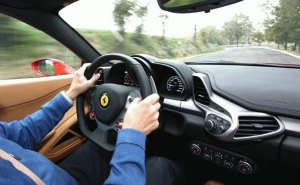
|
Paddle shift is compulsory for the
first time...
|
Together
with the gearbox, the electronic active differential (E-Diff) is an
integral part of the transaxle to save weight. E-Diff was a trump card
of the previous F430 and Scuderia. It utilizes internal clutches to
distribute the desired amount of power to either rear wheels,
optimizing traction and correcting over/understeer. In the latest
E-Diff 3, mechanical construction is unchanged, but now it shares ECU
with F1-Trac (traction control), enabling them to take
parameters of each other into computation and get the best possible
traction strategy.
Not just that, E-Diff and F1-Trac now also communicate with ABS. Such
electronic integration might look trivial, but in fact it requires very
specialized techniques and great amount of testing to get it working,
something Ferrari's F1 engineers are not short of. Like most other
manufacturers - Porsche and Lamborghini included - we used to
underestimate the power of electronic integration. However, the
emergence of 430 Scuderia opened our eyes, showing how great electronic
integration can improve handling and ride. This area is further
explored by 458 Italia.
458 is the first Ferrari V8 mainstream model to abandon steel brakes
and equip Brembo CCM brakes as standard. These carbon-ceramic discs
measure 398mm up front and 360mm at the rear. They are clamped by 6-pot
and 4-pot aluminum calipers respectively. Predictably, the main
benefits of CCM brakes are fade-free stopping performance and low
unsprung weight. However, Ferrari doesn't stop there. Working together
with Bosch, the ABS system pioneers a "Prefill" function. As soon as it
senses the driver lifts off throttle, it will energize the calipers to
press the brake pads softly on the discs. Therefore once the driver
hits the brake pedal, strong braking can be achieved instantly.
Enough technical bits. It's time to
have a ride.
On
the Road
Before entering the cockpit, you will notice how better its build
quality is compared to F430. Admittedly, previous Ferraris have never
been renowned for build quality, no matter compare with Lamborghini or
Porsche. Now with tight fit panels and narrow assembly gaps, its
quality finally goes in line with its performance.
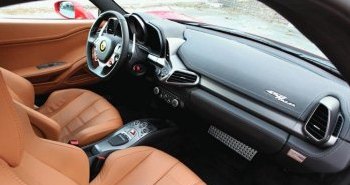
|
The first stylish Ferrari cockpit for
at least 30 years
|
Open the doors, the improvement is even more obvious. For
the first
time in at least 30 years, we can use the word "stylish" to describe a
new Ferrari cockpit. Look at that compact instrument pod surrounded by
flying air vents ! It seems like lifted from a spaceship ! Thanks must
go to Ferrari's design chief Donato Coco
(exterior is still responsible by Pininfarina). The materials, fit and
finish are vastly improved from last generation. However, style and
quality have not compromised its functions. The whole control interface
is highly oriented to the driver. Facing him straight is a 10000-rpm
(yes, ten-thousand) rev counter and two TFT color screens which display
various driving information and satellite navigation. Most controls can
be found on the steering
wheel, such as gearshift paddles, the now-famous Manettino rotary
switch, adaptive damping, headlights and wiper switches. Air vents and
other controls are just within
fingers reach (alright, maybe fingers of NBA players). The design
philosophy says this is a very focused driving machine.
Then you will discover the soft side of it - the leather
seats are comfortable and multi-adjustable to suit people of different
sizes; the same goes for the telescopic steering wheel. The Italian
"long-arm, short-leg" driving position is a thing of the past. The
cabin has excellent head, shoulder and elbow room, even a decent space
behind the seats for a couple of golf clubs. Cab-forward design leads
to excellent forward visibility, though rear quarter view is a little
difficult. If we have 5 stars to award, this cockpit will take 4.
Start the motor, it immediately settles into a calm, undramatic idle.
You might feel disappointed, but once you squeeze the throttle, you
will find the V8 responds so quickly as if it has no inertia to
overcome. Get passed a quarter of throttle travel, the exhaust bypass
valve opens and the V8 roars into life. What a music ! It is not the
hollow angry bark of F430, but a deeper, purer and more mechanical
sound. The noise intensifies as rev rises, and becomes really addictive
at 7000 rpm - by then you still have 2000 rpm to enjoy the full song !
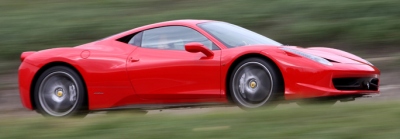 |
The noise becomes really addictive at
7000 rpm - by then you still have 2000 rpm to enjoy...
|
Just
when you are listening to the engine, two more things catch your
attention. First, the new V8 has real mid-range punch. Its torque curve
is so much stronger and broader than F430's. You no longer needs to
wait for the engine to pick up rev, because it responds to your input
almost instantly with strong acceleration. Second, the acceleration
process is so smooth, so clean and so easy, thanks to the seamless yet
instantaneous gearshift of the dual-clutch transmission. It makes the
driving experience so impressive. There is hardly any regret to lose
the old F1 gearbox.
Chassis dynamics is no less impressive. We used to adore the
lightweight 430 Scuderia for its sharp handling and livable ride. It
set a high standard for 458 Italia to match. However, the new car
hasn't disappointed us. In fact, it is even better than the Scuderia,
especially in steering and ride. Thanks to the new rear suspension
geometry and increased body control, it can adopt a super-fast steering
rack with 2.0 turns lock to lock. Once you have your brain recalibrated
to the standard of 458, you will realize how annoyingly slow the old
car steered its front wheels. In contrast, the new car is so handy.
Tight corners can be overcome with no more than a 90-degree flick of
the
steering wheel. Despite of its directness, it is surprisingly light,
thanks to an improved hydraulic assistance. Neither does it feel
nervous. On the contrary, the nose is better tied down to the road than
the old car. It has more front end grip and more consistency in the way
it turns into corners. In the end, you find more communication from the
front wheels and more confidence as a result.
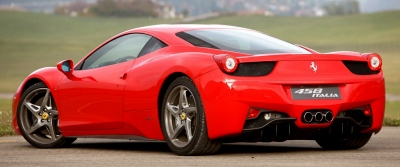 |
Once you have your brain recalibrated
to the standard of 458, you will realize how annoyingly slow the
Scuderia steered its front wheels...
|
With
570 horsepower and 398 pound-foot torque on tap, and lacking a 4-wheel
drive system like Lamborghini or Audi R8, this Ferrari has many excuses
not to have its handling well tamed. But in reality, its handling is
nothing short of sensational. What makes the best use of its immense
grip is not your driving skill, but the clever E-Diff and F1-Trac. You
won't feel the intervention of these electronic aids until reading the
light flashes busily on the TFT screen. They are so well integrated
with the chassis, so that they add to the driving experience rather
than take it out from you. The Manettino switch offers 5 modes -
Slippery, Sport, Race, CT (traction control) off and CST (stability and
traction control) off. Unless you select the last position, you can
hardly destroy its handling. Even in Race mode, you can get a lot of
power slide - just as you desired - without losing final control. This
is perhaps the most impressive aspect of the car.
As in Scuderia, you have the possibility to select the suspension mode
independent of Manettino mode. Anyway, thanks to the new suspension and
magnetorheological dampers, even in Race setting you get a perfectly
acceptable ride comfort. In less aggressive modes, the 458 is a
surprisingly comfortable car. Like Audi R8 V10, it is a perfect
everyday supercar.
Taking into account the marvelous engine, giganic performance, sweet
gearbox, sensational handling and, at last, a sexy look, I wonder who
can beat 458 Italia in the next few years. Ferrari has once again built
a future classic. |
Verdict:
     |
Published
on 17
Nov 2011
|
All rights reserved.
|
|
458 Spider
|
|
Every time I saw
Ferrari
458 Italia on the road, I wondered if anything existing could be more
beautiful. Slim, aggressive and sexy, the V8 model has brought Ferrari
and Pininfarina back to the limelight of automotive design – and
grabbed our Design of the Year award nearly two years ago. However
beautiful it is, the 458 Italia is stepping down from the top spot of
our dream chart. This is because its Spider version has just arrived.
We had fond memories of open-top Ferrari V8s since 308/328GTS. At that
time, targa roof was the norm due to its engineering simplicity. People
were willing to enjoy limited exposure to air as the targa did not
hamper styling and performance, also because there were few
alternatives then. As expectation grew, Ferrari switched to full
convertible with 348 Spider (the early 348ts still came with targa
roof) and then F355 Spider. In the following 360 Spider and F430
Spider, the soft roof arrangement was improved again. Two semi-flying
buttresses and roll-over bars were added behind the cockpit to
reinforce the chassis and comply with safety regulations. Between them
lied a flat glass screen purely for the purpose of displaying the
beautiful engine. To be honest, I think the latter feature was too
flamboyant to a performance-minded brand like Ferrari. An aluminum or
composite engine lid could have shaved a dozen or so kilograms, so why
sacrificed your principles to please playboy millionaires?
The 458 Spider is different. It has abandoned that flat screen for a
conventional engine lid with six ventilation holes. You think that must
be boring? Wrong! It actually looks more classic, just like any good
old mid-engined supercars in the 1970s and 80s. The pair of full-size
flying buttresses is another significant visual improvement from the
small items on its predecessors. Their tallest allow them to integrate
flawlessly with the roll-over protection structure (the black parts),
purifying the shape a lot. They also give the side profile a flavor of
F1 race cars, thus is a perfect match to Ferrari. Overall, the 458
Spider has lifted the integrity of design beyond its fastback coupe
sibling. While the coupe sometimes seems to have a butt too big, the
high-rising flying buttresses just give the Spider a better, more
balanced proportion.
However, the most brilliant is its combination of forms and functions.
The roof system takes only 14 seconds to open or close, versus 20
seconds on F430 Spider. It is a retractable hard roof yet the Spider
weighs only 50 kilograms more than the coupe, with chassis
reinforcement already taken into account ! This is by far the least
weight penalty we have seen. Most rivals gain 100 or so kilos in the
conversion from tin top to open top. Even the fabric roof of F430
Spider had to add 70 kg. Moreover, the 458 Spider sacrifices relatively
little chassis rigidity in the conversion. It lost 30 percent torsional
rigdity from the coupe, versus 45 percent in the case of F430 Spider.
How can the car achieved such amazing results? The answer is an
innovative roof system. It is not a conventional retractable metal
roof, but a further development from the Fioravanti-patented pivoting
system used on the late 575
Superamerica. On the latter, the roof panel
pivoted on B-pillars and flip upside down on the boot lid. The one on
458 is much more sophisticated. It still pivots on the B-pillars, but
the roof stows away in a 100-liter compartment located just behind the
cockpit and partially above the engine compartment – now you know why
the engine lid is slightly raised – All are
covered by a rear-hinged tonneau cover. This keeps the exterior shape
intact, as well as avoids exposing the roof
to dirt. To make possible this storage in limited space, the aluminum
roof panel splits into 2 pieces, with one slides under another in the
process of pivoting. The roof system is engineered and manufactured by
German roof specialist Webesto.
The brilliant roof system means the 458 Spider still leaves room behind
the seats for luggage, perfect for the custom-made suitcases Ferrari
wants to sell you. Unlike all other cars with retractable roof, the
roof system here does not eat into boot space, because the car has a
front boot. It goes without saying that 458 Spider is the first
mid-engined machine employing retractable roof.
The aerodynamics and cooling are a bit different from the coupe.
Following the demise of C-pillars, the air intakes to engine
compartment have to be relocated to just ahead of the taillights –
fortunately, this does not hamper the breathing of the 4.5-liter V8, so
its output figures are intact. Owing to the loss of fastback window,
aerodynamic drag increases slightly, but we are talking about only an
increase from 0.33 to 0.335. As a result, top speed drops by only 3 mph
to a still eye-popping 199 mph. 0-62 mph acceleration is claimed to be
identical to the coupe, as the effect of 50 extra kilograms is not
obvious.
Although major mechanicals are the same, the Spider has different
tuning to suit its less hardcore character. Its magnetorheological
dampers get softer. Engine mapping is revised to deliver gentler
throttle response. ESP is also remapped to be less dramatic.
In the cockpit, you will find the flying buttresses hurt a little bit
rear-quarter visibility, but the environment feels open enough with the
roof stowed away and all windows lowered. Wind management is good. The
vertical rear window can be raised electrically to double as a wind
deflector. With the roof up, the cabin is just as
quiet as the coupe.
How about the driving? Just
as exciting as the 458 coupe. Yes, on really bad surfaces you do sense
the loss of chassis rigidity through vibration and flex which are
absolutely absent on the hardtop. You might also find it understeers a
shade earlier, but such difference is only detectable on race track –
the fact that Ferrari said it is only half a second slower a lap in
Fiorano is a testament to its strong handling. On public roads, the
Spider is remarkably close to the coupe. It amazes you with super-quick
and accurate steering, razor-sharp body control, immense grip,
jaw-dropping braking power and an agility that Lamborghini drivers will
jealous. Ride quality is excellent for a supercar. The engine and
performance are still a big part of its equation. Now with the roof
opened, you can enjoy the thundering roar even more.
In terms of ultimate handling, the 458 coupe does have an edge over the
Spider. However, taking into account aural excitement, open-air freedom
and especially the even sexier look, for the first time ever I think
the Spider version could be a better choice than the equivalent Ferrari
V8 coupe. What an achievement ! |
Verdict:      |
| Published
on 30
Dec 2013 |
All rights reserved.
|
|
458 Speciale
|
|
458 is a mighty
junior supercar. In the past 4 years it won just about every comparison
test, no matter against McLaren MP4-12C, Mercedes SLS AMG, Lamborghini
Gallardo Superleggera or Lexus LFA. It seems that there is no need to
build a better car yet, and it is hard to imagine what can be improved
further, but we know Ferrari has a track record to do so. In 2003, it
modified 360 Modena into a lightweight, highly tuned special called 360
Challenge Stradale. 4 years later, 430 Scuderia was born with the same
philosophy. Both cars thrilled the world with jaw-dropping speed, sound
and razor-sharp handling. Now the mid-life 458 is also given the same
treatment. Its sportier derivative is called 458 Speciale.
Supercar prices have risen a lot in the past decade. 10 years ago, the
Challenge Stradale commanded £133,000 or 30 percent more than the
standard car. This rose to £175,000 for Scuderia and now
£208,000 for the 458 Speciale. Nevertheless, the latter is only
17 percent more than 458 Italia. It actually represents a great value
for money because this price premium covers extensive upgrades to the
engine, gearbox, chassis and aerodynamics. It also gives you an
arguably better looking set of clothes.
Many people said 458 is the sexiest sports car design of this
generation – one that comparable to the classic Dino and 308GTB – but I
would say the 458 Speciale looks even better. The changes it made are
not vast, and they are mostly confined to the nose and tail, but their
visual effect is not to be underestimated. Up front, the black
rectangular fascia has been replaced with an F1-style spoiler, which
draws airflow towards the extra openings on front bonnet. Having seen
the new nose, I suddenly realize how bland the original fascia looks on
a car so sleek and aggressive. Combining functions and aesthetic, the
new nose is what the original design should have been.
Aerodynamics has taken an even more important role on the Speciale.
Vertical vanes have been added to either side of the nose and the
trailing edge of side skirt to guide airflow and reduce turbulence. The
adjustable rear spoiler becomes more pronounced. To make room for a
larger diffuser at the tail, the centrally-mounted triple exhaust has
been rearranged to 2 separate exhausts and positioned at higher level.
There are more active aerodynamic aids adopted, too. The white vertical
flaps located just behind the chromed Prancing Horse at the nose are
movable by air pressure. At higher speed they open to direct air away
from the radiators so to reduce drag. The black horizontal flap
locating underneath them moves at high speed to balance the downforce
between front and rear axle. Besides, the rear diffuser has 3
motor-operated flaps to alter downforce and drag. In short, this car
has the most sophisticated aero package in the road car world.
Like its spiritual predecessors, the 458 Speciale is a lightweight
special, but it is not exactly "striped out". Air-con, audio system and
sat-nav have been retained in the cabin as many modern drivers cannot
live without them. It saves weight in elsewhere, such as using a pair
of carbon-fiber bucket seats, carbon-fiber door panels and getting rid
of glovebox and carpets. Leather upholstery has been replaced with
Alcantara to trim a little bit weight while making the interior
ambience more serious. It also adopts thinner glass, Lexan rear screen,
lighter bumpers and lighter forged alloy wheels. The grand total of
saving is 90 kg, less than the 110 kg on 360 Challenge Stradale and 100
kg on 430 Scuderia. Still, a kerb weight of just under 1400 kg is
remarkable for anything so powerful.
Yes, this thing is really powerful. It now possesses more than 600
horsepower! The exact figure is 605, 35 up from the standard car and it
is released at an unchanged 9000 rpm. The flat-crank naturally
aspirated V8 remains displacing at 4.5 liters. What allows it to
achieve a record-breaking specific output of 134.5 hp/liter is
primarily an unprecedented 14.0:1 compression ratio, which is a big
jump from the 12.5:1 on the standard car and eclipses the 13.5:1 on F12
and LaFerrari. Maranello did not give detailed explanation how the high
compression is made possible, just said it adopted an improved
anti-knock control system which can sense the ionization across the
spark plug gaps more precisely. The engine also adopts shorter inlet
ducts and higher valve lift to improve breathing. Internal friction is
reduced by diamond-like coating on piston pins and new materials for
con-rod bushings. The new pistons are lighter. The air filter box and
intake plenums have been converted to carbon-fiber. In addition to a
lighter exhaust system, the whole engine is slashed by 8 kilograms.
Ferrari said peak torque is unchanged, but in the real world the new
engine feels stronger at any rev. 0-60 mph is now accomplished in an
astonishing 2.9 seconds, 3/10s quicker than the Italia. Admittedly,
part of this improvement is down to the upgraded software of F1
gearbox, which enables 20 percent faster upshifts and 44 percent
quicker downshifts without compromising smoothness. The swiftness of
its gearchanges is simply incredible, more so than any other Ferrari F1
transmissions. More so than the very best PDK box of 911 GT3, too.
The 458 Speciale is capable to lap Fiorano in 1 min 23.5 sec, 1.5 sec
shorter than the standard car and only half a second slower than F12.
It can corner at an astonishing 1.33 g, an unprecedented figure for
Ferrari road cars. Making this possible is primarily a new set of
Michelin Pilot Sport Cup 2 tires with tailor-made compound. They
generate 6 percent more grip than those of the Italia. Other supporting
stuffs include a stiffer suspension setup (25 percent stiffer springs),
new generation magnetorheological adaptive dampers (quicker response)
and updated carbon-ceramic brakes (more powerful and consistent). It is
simply better in every aspect of handling. Every movement becomes
sharper and more accurate. The immense grip and enhanced downforce
allow it to maneuver faster and deeper, while the stiffer suspension
keeps body roll to the minimum. The razor-sharp steering becomes even
more confident inspiring. Thankfully, the ride quality is still
compliant enough on B-roads if you leave the damping in the softest
mode. Only the excessive road noise and engine roar prevent it from
matching the standard car for everyday usability.
However, the most impressive upgrade is actually a piece of software
called Side Slip Control (SSC). It integrates the existing F1-Trac
(traction control) and E-diff (electronic active differential) to
enable power slide without disabling the ESP safety net. When you enter
a corner, the SSC predicts your desire to oversteer from the throttle
position and steering angle, then it calculates the required slip angle
and adjusts engine power and E-diff to implement. If you enter the
corner too fast, it will trim engine power to sort things out. What's
so special? While ESP sorts things abruptly by braking individual
wheels, the SSC works seamlessly and invisibly behind the scene, so
you will find oversteer can be induced and maintained at will, and you
might think yourself become an equal of Michael
Schumacher! This makes the car incredibly fun to drive in the twisty.
The 458 Speciale is better than the standard Italia almost in every
way. It looks better, it goes and stops faster, it reacts to steering
and gearshift quicker, it corners swifter, and it power slides more
beautifully. Most important, it is not a pure track special but a car
that you can enjoy driving on normal roads. Considering how great the
458 Italia still is, Ferrari doesn't need to create this car actually,
but once again it shows the relentless will of pursuing better. This is
a masterpiece, and the best way to seal our memory of 2013.
|
Verdict:      |
|
|
|
|
|
|
|
|
|
|
458 Italia
|
2009
|
Mid-engined,
RWD
|
Aluminum spaceframe
|
| Mainly aluminum |
| 4527 / 1937 / 1213 mm |
| 2650 mm |
V8, 90-degree
|
| 4497 cc |
DOHC 32 valves, DVVT
|
VIM
|
| DI |
570 hp / 9000 rpm
|
398 lbft / 6000 rpm
|
7-speed twin-clutch
|
F: double-wishbones
R: multi-link
|
Adaptive damping
|
F: 235/35ZR20
R: 295/35ZR20 |
1485 kg
|
202 mph (c) / 204 mph*
|
3.2 (c) / 3.2* / 3.3** / 3.3*** /
3.0**** / 3.0^
|
6.5* / 7.0** / 6.9*** / 6.5**** /
6.7^ |
16.2** /
15.0****
|
|
458 Spider
|
2011
|
Mid-engined,
RWD
|
Aluminum spaceframe
|
| Mainly aluminum |
| 4527 / 1937 / 1211 mm |
| 2650 mm |
V8, 90-degree
|
| 4497 cc |
DOHC 32 valves, DVVT
|
VIM
|
| DI |
570 hp / 9000 rpm
|
398 lbft / 6000 rpm
|
7-speed twin-clutch
|
F: double-wishbones
R: multi-link
|
Adaptive damping
|
F: 235/35ZR20
R: 295/35ZR20 |
1535 kg
|
199 mph (c)
|
3.2 (c)
|
-
|
-
|
|
458 Speciale
|
2013
|
Mid-engined,
RWD
|
Aluminum spaceframe
|
| Mainly aluminum |
| 4571 / 1951 / 1203 mm |
| 2650 mm |
V8, 90-degree
|
| 4497 cc |
DOHC 32 valves, DVVT
|
VIM
|
| DI |
605 hp / 9000 rpm
|
398 lbft / 6000 rpm
|
7-speed twin-clutch
|
F: double-wishbones
R: multi-link
|
Adaptive damping
|
F: 235/35ZR20
R: 295/35ZR20 |
1395 kg (1290 kg dry)
|
202 mph (c)
|
2.9 (c) / 3.2**
|
6.8**
|
-
|
|
|
|
|
|
Performance
tested by: *Quattroruote, **Autocar, ***AMS, ****C&D, ^R&T
|
|
|
|
|
|
|
|
|
Copyright©
1997-2013
by Mark Wan @ AutoZine
|
|